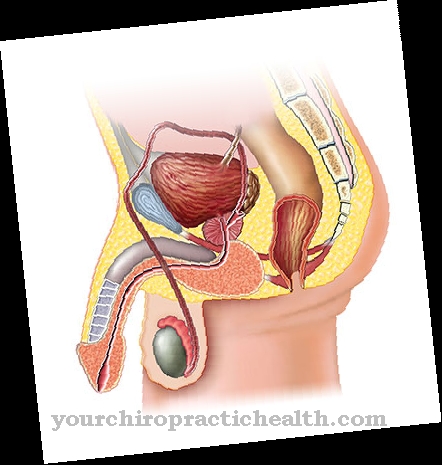A Labor weakness is the weak or unproductive occurrence of labor during the birth of a child or their absence at all. In so-called hypotonic or normotonic labor weakness, the state of tension of the uterine contractions (myometrium) is normal, but the contractions are too weak, too short or too low in frequency. The cervix remains closed longer than intended. Hypertonic labor weakness is when the contractions are uncoordinated even though the tension, frequency, duration, and strength of the contractions are normal or even increased.
What is weakness in labor?
Labor may be poor from the start of labor (primary Labor weakness) or only subside in its course (secondary weakness in labor). A short-term weakness in labor when the amniotic sac or due to the initiation of local anesthesia in the area of the spinal cord of the parturient is relatively insignificant for the birth process.
Primary weakness in labor occurs when the excitation of the woman giving birth is locally misdirected in the myometrium or when the abdominal or uterine muscles are torn. Other possible causes can be the use of medication during pregnancy or related metabolic disorders.
Very rarely does it happen that the pressure on the child's cervix and vagina is less than usual, so that not enough oxytocin (“labor hormone”) is released. This can happen, for example, if the child lies abnormally in the breech position.
Even if the patient does not wait head first in the birth canal, but is in a transverse position, the cervix is only insufficiently stimulated and consequently labor activity is hindered. It is not uncommon for the cervix to be only two or three centimeters open shortly before delivery.
causes
Secondary weakness in labor occurs when the uterus is overstretched (large child, multiple births, several deliveries in quick succession) or an excess of amniotic fluid. An excessively long labor or a woman's pelvis that is too small can also be responsible for this.
Emptying the urinary bladder and thus the relative disinhibition of the uterus often helps against secondary weakness in labor. Overstimulation of the uterus could be a hidden cause of inadequate labor force. This can be evoked by drugs that actually promote labor, pain relievers or narcotic substances.
Symptoms, ailments & signs
If the due date has been exceeded significantly due to a weak contraction, the mother and the unborn child are carefully and regularly monitored with the help of a CTG (cardiotocography, "contractions recorder"). This continuously measures the child's heartbeat and the mother's labor intensity.
Ultrasound examinations are also possible. Transferring the baby from the beginning of the 43rd week of pregnancy is not immediately dangerous, but it does involve some risks for both mother and child. As soon as dangers are recognizable, the birth is usually initiated. This happens very often with labor-inducing agents that are administered via an infusion or vaginal gel. In addition, the administration of the labor hormone oxytocin is possible.
Diagnosis & course of disease
In cases of secondary weakness in labor, however, psychological reasons on the part of the expectant mother can also play a role. Temporary inactivity is sometimes a way for the heavily pregnant woman to take a little rest and breathe. The atmosphere in the clinic's delivery room, the hectic pace and routine hospital routine also contribute to easing the contractions.
The pregnant woman also has various options for gently reactivating her own contractions. These range from emptying the bladder (possibly with a catheter) to taking a short walk or light exercise in the fresh air to a warm bath. Depending on the situation and the woman's state of exhaustion, a light massage, a hot water bottle, a few relaxation exercises, acupuncture, a small meal and sufficient drink can also help.
Complications
A weak contraction usually does not result in any major complications. For the expectant mother, however, the additional weeks of pregnancy represent a considerable burden, both physically and mentally, because the absence of contractions always causes fears. Above all, if the labor activity does not take place well beyond the 40th week of pregnancy or is only very weak, this can be a burden for the woman concerned.
A weakness in labor has no effect on the child, provided that a natural birth can ultimately be induced. Treating contractions has certain risks. Occasionally, the home remedies used to speed up the birth process cause discomfort. Essential oils can irritate the genital area, while ginger or clove oils sometimes cause allergic reactions.
The administration of labor hormones can bring the body's own processes out of balance and thus have the opposite effect - labor starts even later. Supportive means such as pliers or a suction cup always involve the risk of injuring the mother or child. A caesarean section is also associated with the risk of injury, but wound healing disorders or infections can also occur.
When should you go to the doctor?
Women who find they might be pregnant should always consult a doctor. The course of the pregnancy and the later parturition must be monitored and planned in good time. In addition, the expectant mother should inform herself in good time and comprehensively about the upcoming changes and possible developments during pregnancy. In particular, the physical development process must be found out so that surprises can be avoided and, in the event of abnormalities, the attending physician can be consulted immediately. In the final phase of pregnancy, usually around the time of the calculated due date, labor begins. It should therefore be clarified and planned in good time where the birth is to take place.
When giving birth, it is strongly recommended that trained medical personnel be used. If there are any peculiarities during the birth process, they can act immediately. With the onset of the first contraction, go to the nearest hospital or birthing center. Alternatively, the midwife should be informed if a home birth is planned. During the birth process, the contractions are monitored by the obstetricians. Your instructions should be followed to minimize possible complications. In the event of sudden pain in the abdomen or the absence of menstruation for several months, a doctor should also be consulted.
Treatment & Therapy
For the massage, for example, ten milliliters of almond oil are drizzled together with two teaspoons of iron root oil, ginger oil, clove oil and cinnamon oil. When the pregnant woman's belly has been moistened with warm water by herself or her partner, the fine oil mixture is gently massaged in. Its components all stimulate the muscles of the uterus and thus promote labor pains.
Essential oils and herbs (cinnamon, cloves, ginger) can be added to the warm bath according to personal taste. However, a person should always be nearby during this warm bath, because depending on the state of the circulatory system, the labor rhythm can increase very quickly on this occasion. If the pregnant woman is still at home, sexual intercourse is also a suitable means of stimulating labor, if it is possible and desired in the specific situation.
Sexual arousal should be able to release the labor hormone oxytocin. In addition, male sperm contains tissue hormones that are also used for drug induction. You can enlarge the cervix and loosen the muscles of the uterus. A tea with ingredients that promote labor such as cinnamon, ginger and verbena, drunk lukewarm throughout the day, has similar effects. Even a few cups of raspberry leaf tea serve this purpose in a very healthy and encouraging way.
If the contractions still don't get going and medicinal products do not help as desired, supportive means such as suction cups or forceps may be used at a crucial stage of the birth. The doctors and midwives will then, with the consent of the mother, have to decide on a caesarean section at the right time if necessary.
prevention
Since the entire birth process runs individually from woman to woman and weak contractions occur sporadically, it cannot be prevented.
Aftercare
Labor weakness is a complication that only occurs during labor. Otherwise it does not lead to any adverse effects. Because of this birth complication, no special follow-up measures are usually necessary. Regardless of the weakness in labor, however, some examinations after the birth are generally recommended.
In a few cases, this birth complication is what is known as primary uterine weakness, which can have genetic causes. For the women affected, it can be very helpful to have further follow-up examinations carried out by the gynecologist. This is particularly advisable if the patient has already suffered from weakness in contractions during previous births or in close relatives.
Such examinations are only useful if there are further pregnancies or if these are planned. The weakness in labor does not have to be examined immediately after birth. This can also be done as part of further prenatal care. A closer investigation of the causes of the weakness in labor is generally helpful, so that the affected women and the gynecologist can prepare for future births and react in good time. Otherwise, however, primary weakness in labor does not lead to any symptoms and does not need to be treated.
You can do that yourself
If the patient is suffering from weak contractions, it is essential that they seek medical treatment. Self-help measures alone are usually not effective. However, there are a few methods that can be used to gently stimulate labor and ease the situation.
The first thing you should do to get better in many cases is to empty your bladder. In consultation with the attending physician or midwife, other self-help methods can be used. Movement often has a beneficial effect on weakness in labor. Short walks in the company of another person are recommended. In some cases, gentle yoga exercises can help overcome contractions. In general, it is advisable to take an upright position. In addition, a bath with warm water can have a positive effect on contractions. Additional light massages and acupressure are helpful.
If you are very exhausted, it is advisable to sleep for some time. In addition, the women affected should eat something. Dextrose also has a supportive effect. Adequate hydration should be ensured. The women affected should try to relax as much as possible. Certain breathing techniques can help.
























.jpg)



